Reflective Essay: Key Learnings in Business Communication Course
VerifiedAdded on 2023/06/05
|10
|2378
|290
Essay
AI Summary
This essay is a reflective account of learning experiences in a business communication course. It covers various aspects of effective communication, including interpersonal, intra-personal, and cross-cultural communication. The essay highlights the importance of listening skills, written communication, academic writing, and reflective essay writing. It includes a literature review on cross-cultural communication, emphasizing the significance of understanding different cultures and breaking stereotypes to enhance communication. The essay also reflects on the development of presentation skills and the importance of interpersonal communication, particularly assertive communication, in a business context. The course's overall impact on improving communication skills and preparing for future career challenges is emphasized. Desklib provides students access to similar essays and study tools.
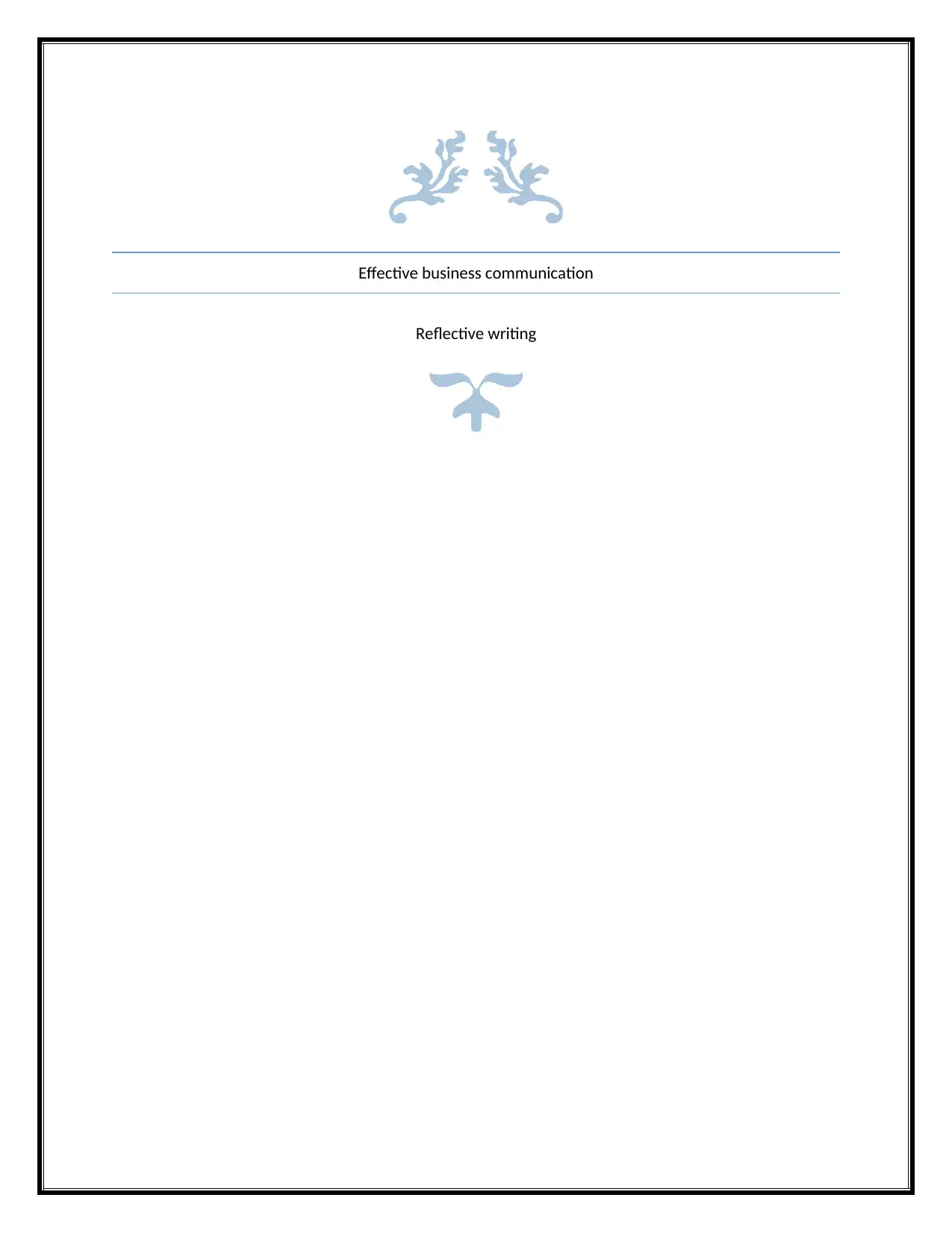
Effective business communication
Reflective writing
Reflective writing
Paraphrase This Document
Need a fresh take? Get an instant paraphrase of this document with our AI Paraphraser
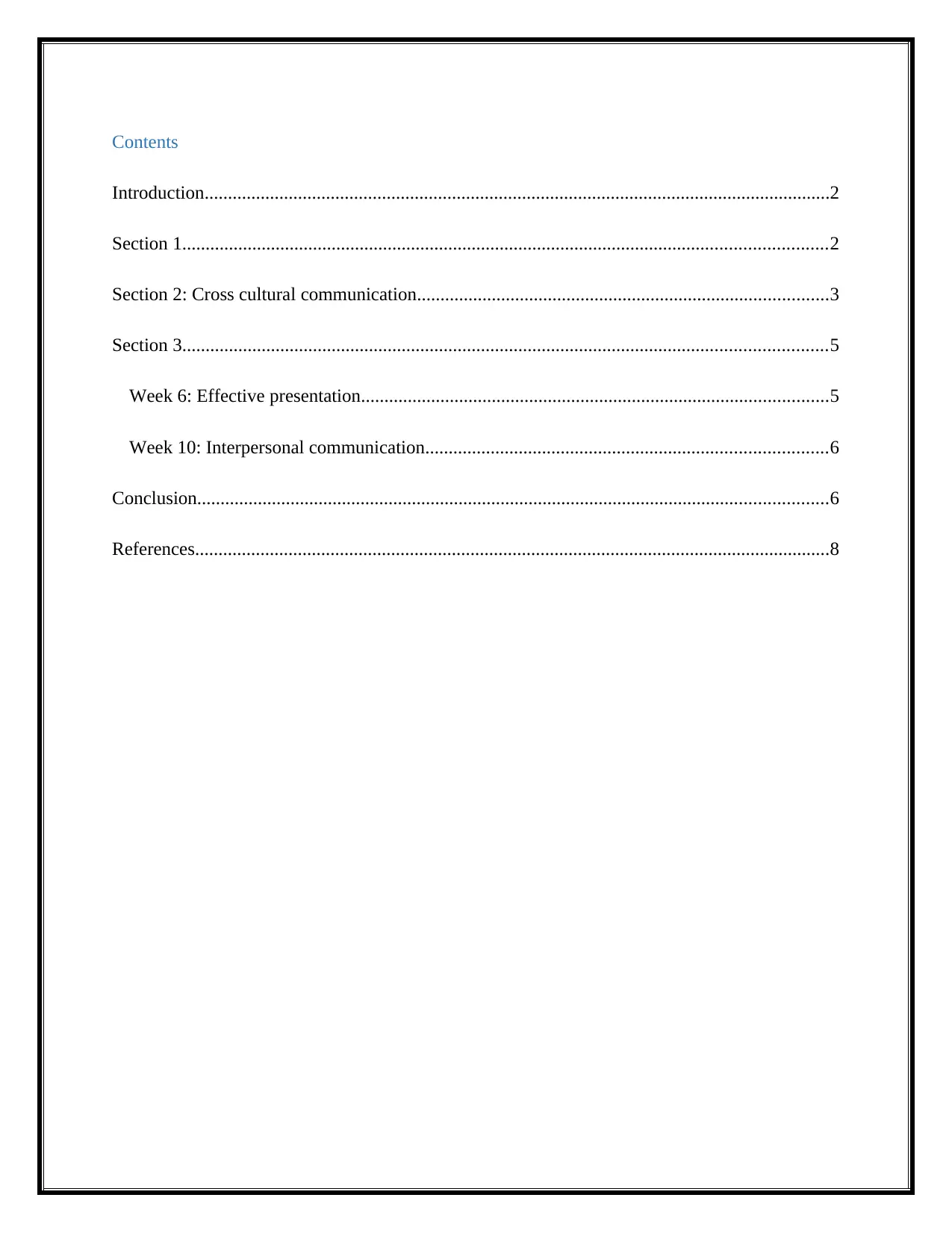
Contents
Introduction......................................................................................................................................2
Section 1..........................................................................................................................................2
Section 2: Cross cultural communication........................................................................................3
Section 3..........................................................................................................................................5
Week 6: Effective presentation....................................................................................................5
Week 10: Interpersonal communication......................................................................................6
Conclusion.......................................................................................................................................6
References........................................................................................................................................8
Introduction......................................................................................................................................2
Section 1..........................................................................................................................................2
Section 2: Cross cultural communication........................................................................................3
Section 3..........................................................................................................................................5
Week 6: Effective presentation....................................................................................................5
Week 10: Interpersonal communication......................................................................................6
Conclusion.......................................................................................................................................6
References........................................................................................................................................8
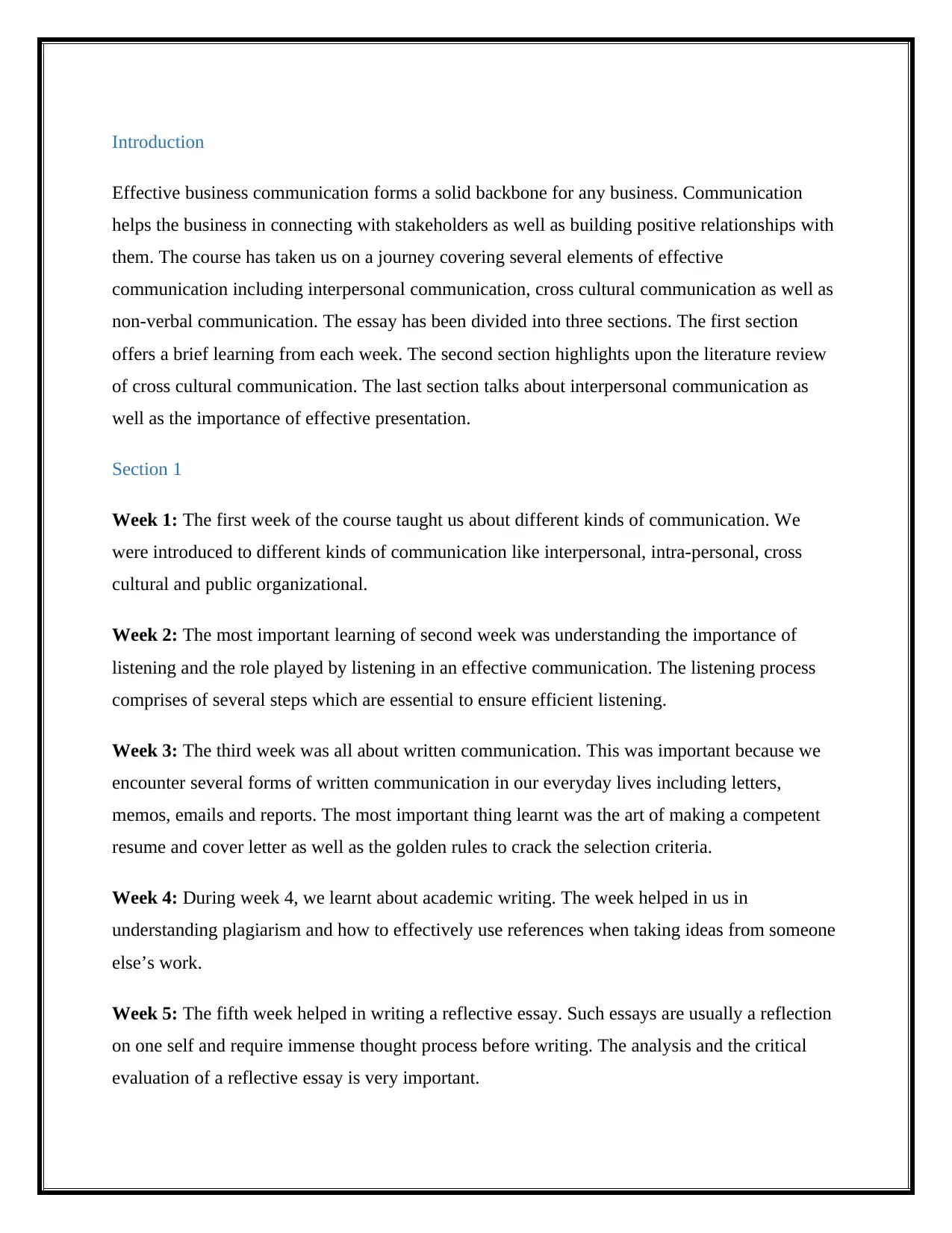
Introduction
Effective business communication forms a solid backbone for any business. Communication
helps the business in connecting with stakeholders as well as building positive relationships with
them. The course has taken us on a journey covering several elements of effective
communication including interpersonal communication, cross cultural communication as well as
non-verbal communication. The essay has been divided into three sections. The first section
offers a brief learning from each week. The second section highlights upon the literature review
of cross cultural communication. The last section talks about interpersonal communication as
well as the importance of effective presentation.
Section 1
Week 1: The first week of the course taught us about different kinds of communication. We
were introduced to different kinds of communication like interpersonal, intra-personal, cross
cultural and public organizational.
Week 2: The most important learning of second week was understanding the importance of
listening and the role played by listening in an effective communication. The listening process
comprises of several steps which are essential to ensure efficient listening.
Week 3: The third week was all about written communication. This was important because we
encounter several forms of written communication in our everyday lives including letters,
memos, emails and reports. The most important thing learnt was the art of making a competent
resume and cover letter as well as the golden rules to crack the selection criteria.
Week 4: During week 4, we learnt about academic writing. The week helped in us in
understanding plagiarism and how to effectively use references when taking ideas from someone
else’s work.
Week 5: The fifth week helped in writing a reflective essay. Such essays are usually a reflection
on one self and require immense thought process before writing. The analysis and the critical
evaluation of a reflective essay is very important.
Effective business communication forms a solid backbone for any business. Communication
helps the business in connecting with stakeholders as well as building positive relationships with
them. The course has taken us on a journey covering several elements of effective
communication including interpersonal communication, cross cultural communication as well as
non-verbal communication. The essay has been divided into three sections. The first section
offers a brief learning from each week. The second section highlights upon the literature review
of cross cultural communication. The last section talks about interpersonal communication as
well as the importance of effective presentation.
Section 1
Week 1: The first week of the course taught us about different kinds of communication. We
were introduced to different kinds of communication like interpersonal, intra-personal, cross
cultural and public organizational.
Week 2: The most important learning of second week was understanding the importance of
listening and the role played by listening in an effective communication. The listening process
comprises of several steps which are essential to ensure efficient listening.
Week 3: The third week was all about written communication. This was important because we
encounter several forms of written communication in our everyday lives including letters,
memos, emails and reports. The most important thing learnt was the art of making a competent
resume and cover letter as well as the golden rules to crack the selection criteria.
Week 4: During week 4, we learnt about academic writing. The week helped in us in
understanding plagiarism and how to effectively use references when taking ideas from someone
else’s work.
Week 5: The fifth week helped in writing a reflective essay. Such essays are usually a reflection
on one self and require immense thought process before writing. The analysis and the critical
evaluation of a reflective essay is very important.
⊘ This is a preview!⊘
Do you want full access?
Subscribe today to unlock all pages.

Trusted by 1+ million students worldwide
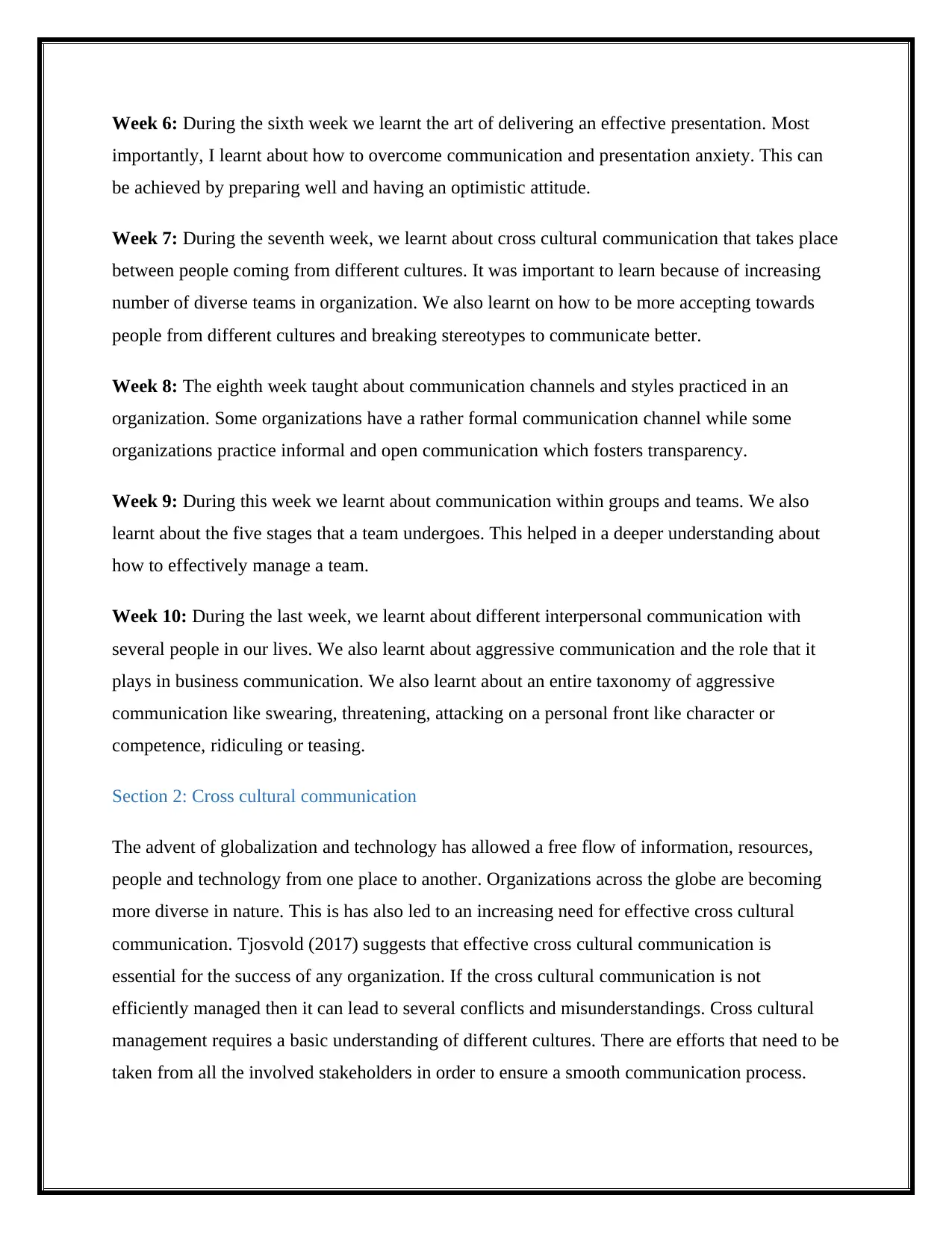
Week 6: During the sixth week we learnt the art of delivering an effective presentation. Most
importantly, I learnt about how to overcome communication and presentation anxiety. This can
be achieved by preparing well and having an optimistic attitude.
Week 7: During the seventh week, we learnt about cross cultural communication that takes place
between people coming from different cultures. It was important to learn because of increasing
number of diverse teams in organization. We also learnt on how to be more accepting towards
people from different cultures and breaking stereotypes to communicate better.
Week 8: The eighth week taught about communication channels and styles practiced in an
organization. Some organizations have a rather formal communication channel while some
organizations practice informal and open communication which fosters transparency.
Week 9: During this week we learnt about communication within groups and teams. We also
learnt about the five stages that a team undergoes. This helped in a deeper understanding about
how to effectively manage a team.
Week 10: During the last week, we learnt about different interpersonal communication with
several people in our lives. We also learnt about aggressive communication and the role that it
plays in business communication. We also learnt about an entire taxonomy of aggressive
communication like swearing, threatening, attacking on a personal front like character or
competence, ridiculing or teasing.
Section 2: Cross cultural communication
The advent of globalization and technology has allowed a free flow of information, resources,
people and technology from one place to another. Organizations across the globe are becoming
more diverse in nature. This is has also led to an increasing need for effective cross cultural
communication. Tjosvold (2017) suggests that effective cross cultural communication is
essential for the success of any organization. If the cross cultural communication is not
efficiently managed then it can lead to several conflicts and misunderstandings. Cross cultural
management requires a basic understanding of different cultures. There are efforts that need to be
taken from all the involved stakeholders in order to ensure a smooth communication process.
importantly, I learnt about how to overcome communication and presentation anxiety. This can
be achieved by preparing well and having an optimistic attitude.
Week 7: During the seventh week, we learnt about cross cultural communication that takes place
between people coming from different cultures. It was important to learn because of increasing
number of diverse teams in organization. We also learnt on how to be more accepting towards
people from different cultures and breaking stereotypes to communicate better.
Week 8: The eighth week taught about communication channels and styles practiced in an
organization. Some organizations have a rather formal communication channel while some
organizations practice informal and open communication which fosters transparency.
Week 9: During this week we learnt about communication within groups and teams. We also
learnt about the five stages that a team undergoes. This helped in a deeper understanding about
how to effectively manage a team.
Week 10: During the last week, we learnt about different interpersonal communication with
several people in our lives. We also learnt about aggressive communication and the role that it
plays in business communication. We also learnt about an entire taxonomy of aggressive
communication like swearing, threatening, attacking on a personal front like character or
competence, ridiculing or teasing.
Section 2: Cross cultural communication
The advent of globalization and technology has allowed a free flow of information, resources,
people and technology from one place to another. Organizations across the globe are becoming
more diverse in nature. This is has also led to an increasing need for effective cross cultural
communication. Tjosvold (2017) suggests that effective cross cultural communication is
essential for the success of any organization. If the cross cultural communication is not
efficiently managed then it can lead to several conflicts and misunderstandings. Cross cultural
management requires a basic understanding of different cultures. There are efforts that need to be
taken from all the involved stakeholders in order to ensure a smooth communication process.
Paraphrase This Document
Need a fresh take? Get an instant paraphrase of this document with our AI Paraphraser
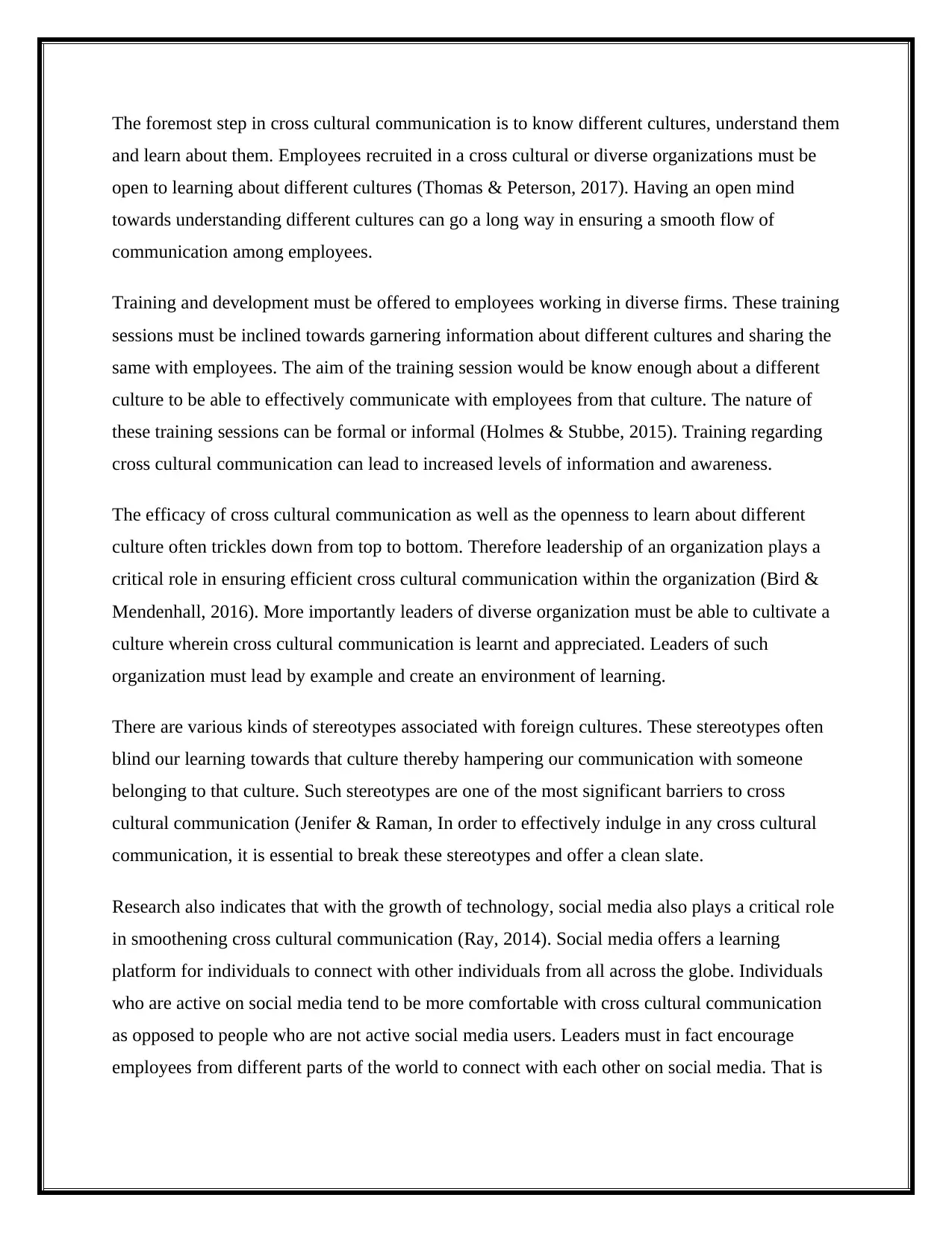
The foremost step in cross cultural communication is to know different cultures, understand them
and learn about them. Employees recruited in a cross cultural or diverse organizations must be
open to learning about different cultures (Thomas & Peterson, 2017). Having an open mind
towards understanding different cultures can go a long way in ensuring a smooth flow of
communication among employees.
Training and development must be offered to employees working in diverse firms. These training
sessions must be inclined towards garnering information about different cultures and sharing the
same with employees. The aim of the training session would be know enough about a different
culture to be able to effectively communicate with employees from that culture. The nature of
these training sessions can be formal or informal (Holmes & Stubbe, 2015). Training regarding
cross cultural communication can lead to increased levels of information and awareness.
The efficacy of cross cultural communication as well as the openness to learn about different
culture often trickles down from top to bottom. Therefore leadership of an organization plays a
critical role in ensuring efficient cross cultural communication within the organization (Bird &
Mendenhall, 2016). More importantly leaders of diverse organization must be able to cultivate a
culture wherein cross cultural communication is learnt and appreciated. Leaders of such
organization must lead by example and create an environment of learning.
There are various kinds of stereotypes associated with foreign cultures. These stereotypes often
blind our learning towards that culture thereby hampering our communication with someone
belonging to that culture. Such stereotypes are one of the most significant barriers to cross
cultural communication (Jenifer & Raman, In order to effectively indulge in any cross cultural
communication, it is essential to break these stereotypes and offer a clean slate.
Research also indicates that with the growth of technology, social media also plays a critical role
in smoothening cross cultural communication (Ray, 2014). Social media offers a learning
platform for individuals to connect with other individuals from all across the globe. Individuals
who are active on social media tend to be more comfortable with cross cultural communication
as opposed to people who are not active social media users. Leaders must in fact encourage
employees from different parts of the world to connect with each other on social media. That is
and learn about them. Employees recruited in a cross cultural or diverse organizations must be
open to learning about different cultures (Thomas & Peterson, 2017). Having an open mind
towards understanding different cultures can go a long way in ensuring a smooth flow of
communication among employees.
Training and development must be offered to employees working in diverse firms. These training
sessions must be inclined towards garnering information about different cultures and sharing the
same with employees. The aim of the training session would be know enough about a different
culture to be able to effectively communicate with employees from that culture. The nature of
these training sessions can be formal or informal (Holmes & Stubbe, 2015). Training regarding
cross cultural communication can lead to increased levels of information and awareness.
The efficacy of cross cultural communication as well as the openness to learn about different
culture often trickles down from top to bottom. Therefore leadership of an organization plays a
critical role in ensuring efficient cross cultural communication within the organization (Bird &
Mendenhall, 2016). More importantly leaders of diverse organization must be able to cultivate a
culture wherein cross cultural communication is learnt and appreciated. Leaders of such
organization must lead by example and create an environment of learning.
There are various kinds of stereotypes associated with foreign cultures. These stereotypes often
blind our learning towards that culture thereby hampering our communication with someone
belonging to that culture. Such stereotypes are one of the most significant barriers to cross
cultural communication (Jenifer & Raman, In order to effectively indulge in any cross cultural
communication, it is essential to break these stereotypes and offer a clean slate.
Research also indicates that with the growth of technology, social media also plays a critical role
in smoothening cross cultural communication (Ray, 2014). Social media offers a learning
platform for individuals to connect with other individuals from all across the globe. Individuals
who are active on social media tend to be more comfortable with cross cultural communication
as opposed to people who are not active social media users. Leaders must in fact encourage
employees from different parts of the world to connect with each other on social media. That is
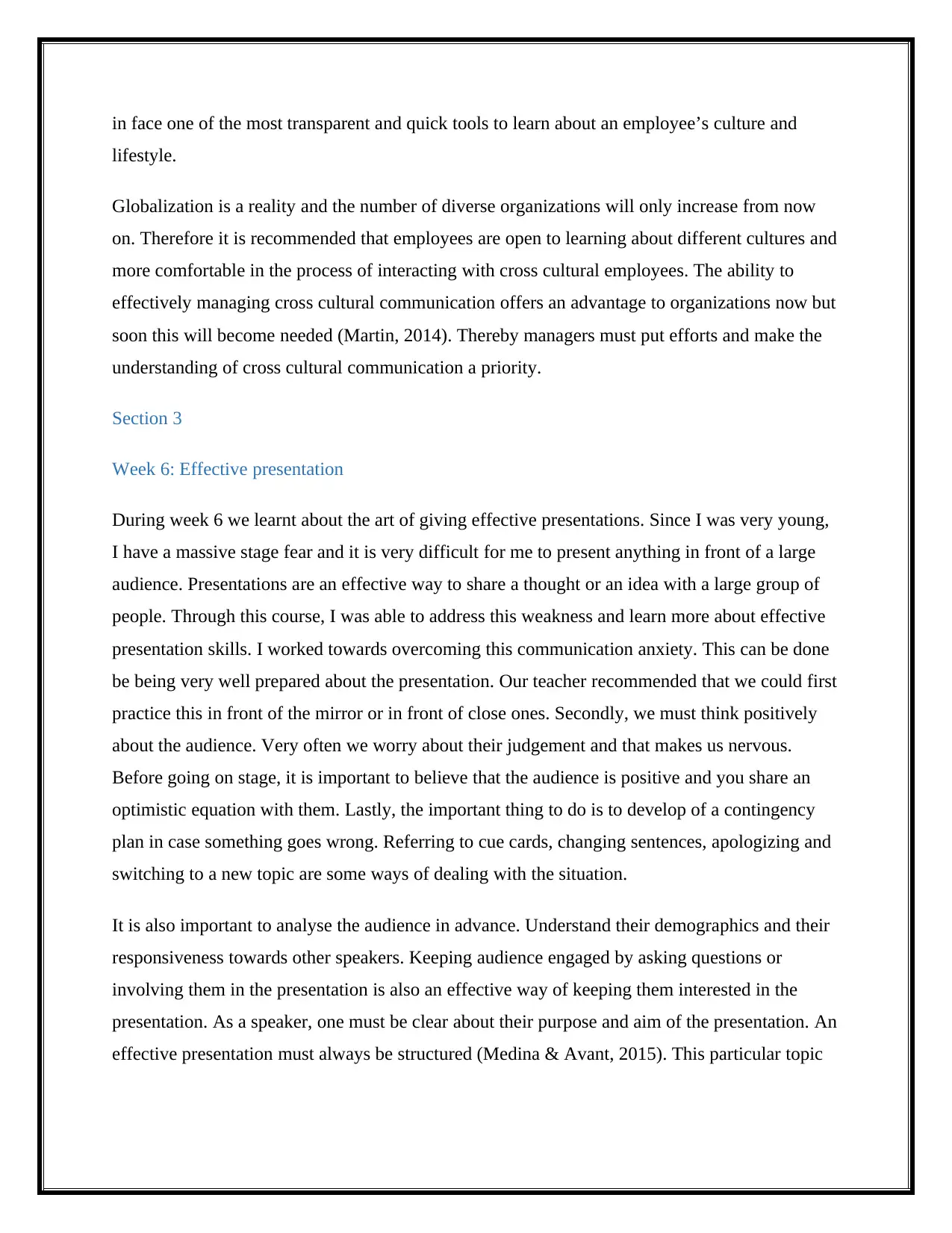
in face one of the most transparent and quick tools to learn about an employee’s culture and
lifestyle.
Globalization is a reality and the number of diverse organizations will only increase from now
on. Therefore it is recommended that employees are open to learning about different cultures and
more comfortable in the process of interacting with cross cultural employees. The ability to
effectively managing cross cultural communication offers an advantage to organizations now but
soon this will become needed (Martin, 2014). Thereby managers must put efforts and make the
understanding of cross cultural communication a priority.
Section 3
Week 6: Effective presentation
During week 6 we learnt about the art of giving effective presentations. Since I was very young,
I have a massive stage fear and it is very difficult for me to present anything in front of a large
audience. Presentations are an effective way to share a thought or an idea with a large group of
people. Through this course, I was able to address this weakness and learn more about effective
presentation skills. I worked towards overcoming this communication anxiety. This can be done
be being very well prepared about the presentation. Our teacher recommended that we could first
practice this in front of the mirror or in front of close ones. Secondly, we must think positively
about the audience. Very often we worry about their judgement and that makes us nervous.
Before going on stage, it is important to believe that the audience is positive and you share an
optimistic equation with them. Lastly, the important thing to do is to develop of a contingency
plan in case something goes wrong. Referring to cue cards, changing sentences, apologizing and
switching to a new topic are some ways of dealing with the situation.
It is also important to analyse the audience in advance. Understand their demographics and their
responsiveness towards other speakers. Keeping audience engaged by asking questions or
involving them in the presentation is also an effective way of keeping them interested in the
presentation. As a speaker, one must be clear about their purpose and aim of the presentation. An
effective presentation must always be structured (Medina & Avant, 2015). This particular topic
lifestyle.
Globalization is a reality and the number of diverse organizations will only increase from now
on. Therefore it is recommended that employees are open to learning about different cultures and
more comfortable in the process of interacting with cross cultural employees. The ability to
effectively managing cross cultural communication offers an advantage to organizations now but
soon this will become needed (Martin, 2014). Thereby managers must put efforts and make the
understanding of cross cultural communication a priority.
Section 3
Week 6: Effective presentation
During week 6 we learnt about the art of giving effective presentations. Since I was very young,
I have a massive stage fear and it is very difficult for me to present anything in front of a large
audience. Presentations are an effective way to share a thought or an idea with a large group of
people. Through this course, I was able to address this weakness and learn more about effective
presentation skills. I worked towards overcoming this communication anxiety. This can be done
be being very well prepared about the presentation. Our teacher recommended that we could first
practice this in front of the mirror or in front of close ones. Secondly, we must think positively
about the audience. Very often we worry about their judgement and that makes us nervous.
Before going on stage, it is important to believe that the audience is positive and you share an
optimistic equation with them. Lastly, the important thing to do is to develop of a contingency
plan in case something goes wrong. Referring to cue cards, changing sentences, apologizing and
switching to a new topic are some ways of dealing with the situation.
It is also important to analyse the audience in advance. Understand their demographics and their
responsiveness towards other speakers. Keeping audience engaged by asking questions or
involving them in the presentation is also an effective way of keeping them interested in the
presentation. As a speaker, one must be clear about their purpose and aim of the presentation. An
effective presentation must always be structured (Medina & Avant, 2015). This particular topic
⊘ This is a preview!⊘
Do you want full access?
Subscribe today to unlock all pages.

Trusted by 1+ million students worldwide
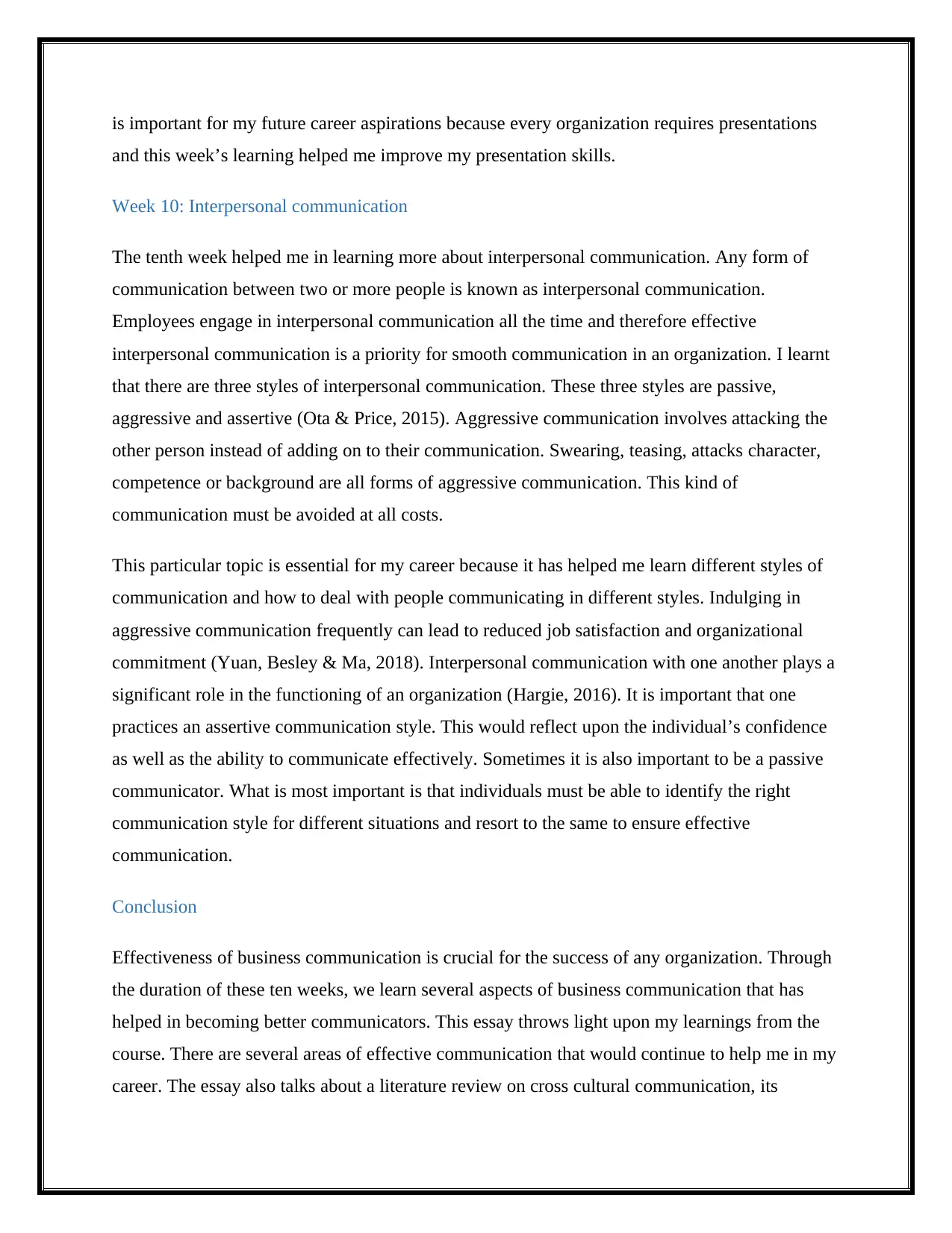
is important for my future career aspirations because every organization requires presentations
and this week’s learning helped me improve my presentation skills.
Week 10: Interpersonal communication
The tenth week helped me in learning more about interpersonal communication. Any form of
communication between two or more people is known as interpersonal communication.
Employees engage in interpersonal communication all the time and therefore effective
interpersonal communication is a priority for smooth communication in an organization. I learnt
that there are three styles of interpersonal communication. These three styles are passive,
aggressive and assertive (Ota & Price, 2015). Aggressive communication involves attacking the
other person instead of adding on to their communication. Swearing, teasing, attacks character,
competence or background are all forms of aggressive communication. This kind of
communication must be avoided at all costs.
This particular topic is essential for my career because it has helped me learn different styles of
communication and how to deal with people communicating in different styles. Indulging in
aggressive communication frequently can lead to reduced job satisfaction and organizational
commitment (Yuan, Besley & Ma, 2018). Interpersonal communication with one another plays a
significant role in the functioning of an organization (Hargie, 2016). It is important that one
practices an assertive communication style. This would reflect upon the individual’s confidence
as well as the ability to communicate effectively. Sometimes it is also important to be a passive
communicator. What is most important is that individuals must be able to identify the right
communication style for different situations and resort to the same to ensure effective
communication.
Conclusion
Effectiveness of business communication is crucial for the success of any organization. Through
the duration of these ten weeks, we learn several aspects of business communication that has
helped in becoming better communicators. This essay throws light upon my learnings from the
course. There are several areas of effective communication that would continue to help me in my
career. The essay also talks about a literature review on cross cultural communication, its
and this week’s learning helped me improve my presentation skills.
Week 10: Interpersonal communication
The tenth week helped me in learning more about interpersonal communication. Any form of
communication between two or more people is known as interpersonal communication.
Employees engage in interpersonal communication all the time and therefore effective
interpersonal communication is a priority for smooth communication in an organization. I learnt
that there are three styles of interpersonal communication. These three styles are passive,
aggressive and assertive (Ota & Price, 2015). Aggressive communication involves attacking the
other person instead of adding on to their communication. Swearing, teasing, attacks character,
competence or background are all forms of aggressive communication. This kind of
communication must be avoided at all costs.
This particular topic is essential for my career because it has helped me learn different styles of
communication and how to deal with people communicating in different styles. Indulging in
aggressive communication frequently can lead to reduced job satisfaction and organizational
commitment (Yuan, Besley & Ma, 2018). Interpersonal communication with one another plays a
significant role in the functioning of an organization (Hargie, 2016). It is important that one
practices an assertive communication style. This would reflect upon the individual’s confidence
as well as the ability to communicate effectively. Sometimes it is also important to be a passive
communicator. What is most important is that individuals must be able to identify the right
communication style for different situations and resort to the same to ensure effective
communication.
Conclusion
Effectiveness of business communication is crucial for the success of any organization. Through
the duration of these ten weeks, we learn several aspects of business communication that has
helped in becoming better communicators. This essay throws light upon my learnings from the
course. There are several areas of effective communication that would continue to help me in my
career. The essay also talks about a literature review on cross cultural communication, its
Paraphrase This Document
Need a fresh take? Get an instant paraphrase of this document with our AI Paraphraser
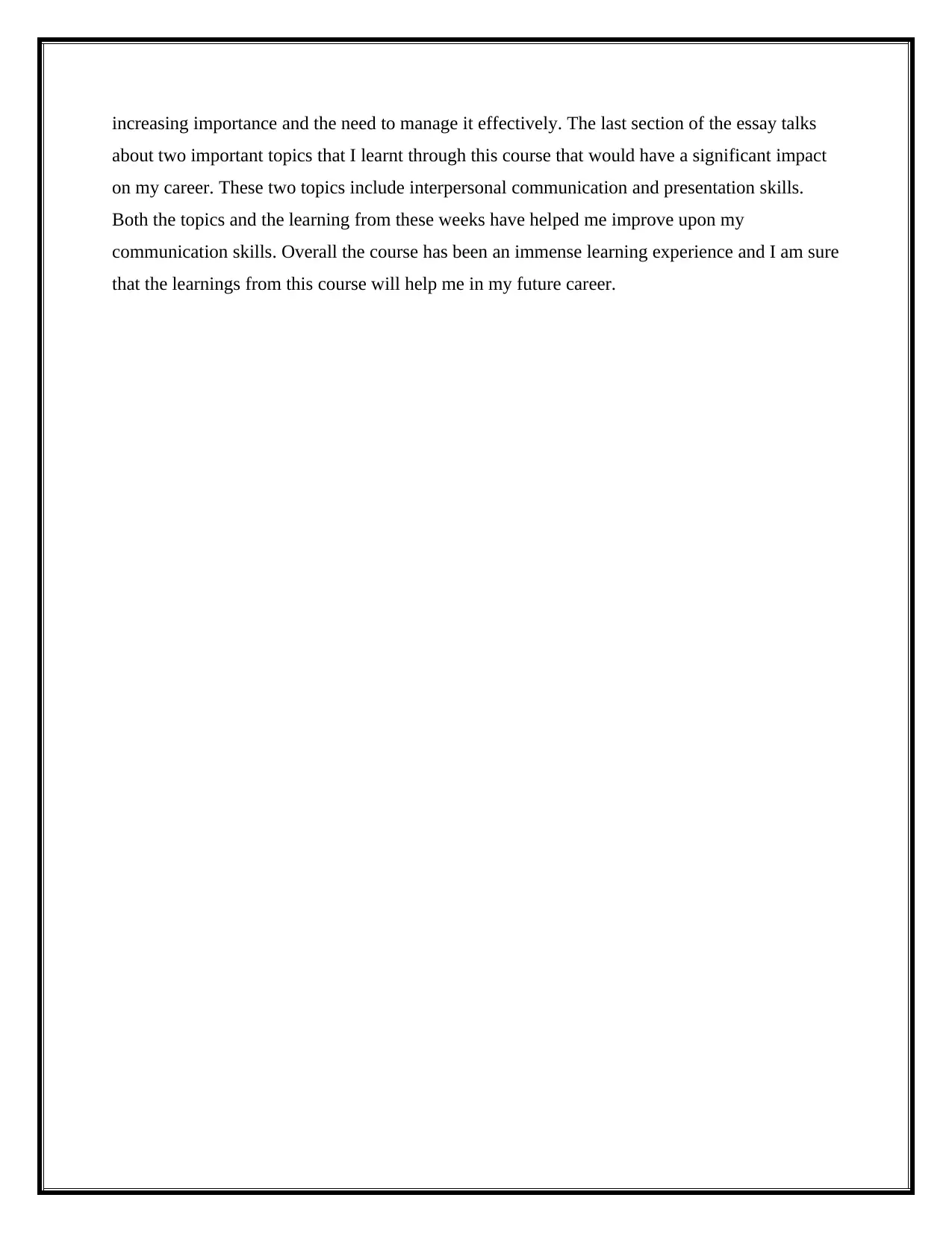
increasing importance and the need to manage it effectively. The last section of the essay talks
about two important topics that I learnt through this course that would have a significant impact
on my career. These two topics include interpersonal communication and presentation skills.
Both the topics and the learning from these weeks have helped me improve upon my
communication skills. Overall the course has been an immense learning experience and I am sure
that the learnings from this course will help me in my future career.
about two important topics that I learnt through this course that would have a significant impact
on my career. These two topics include interpersonal communication and presentation skills.
Both the topics and the learning from these weeks have helped me improve upon my
communication skills. Overall the course has been an immense learning experience and I am sure
that the learnings from this course will help me in my future career.
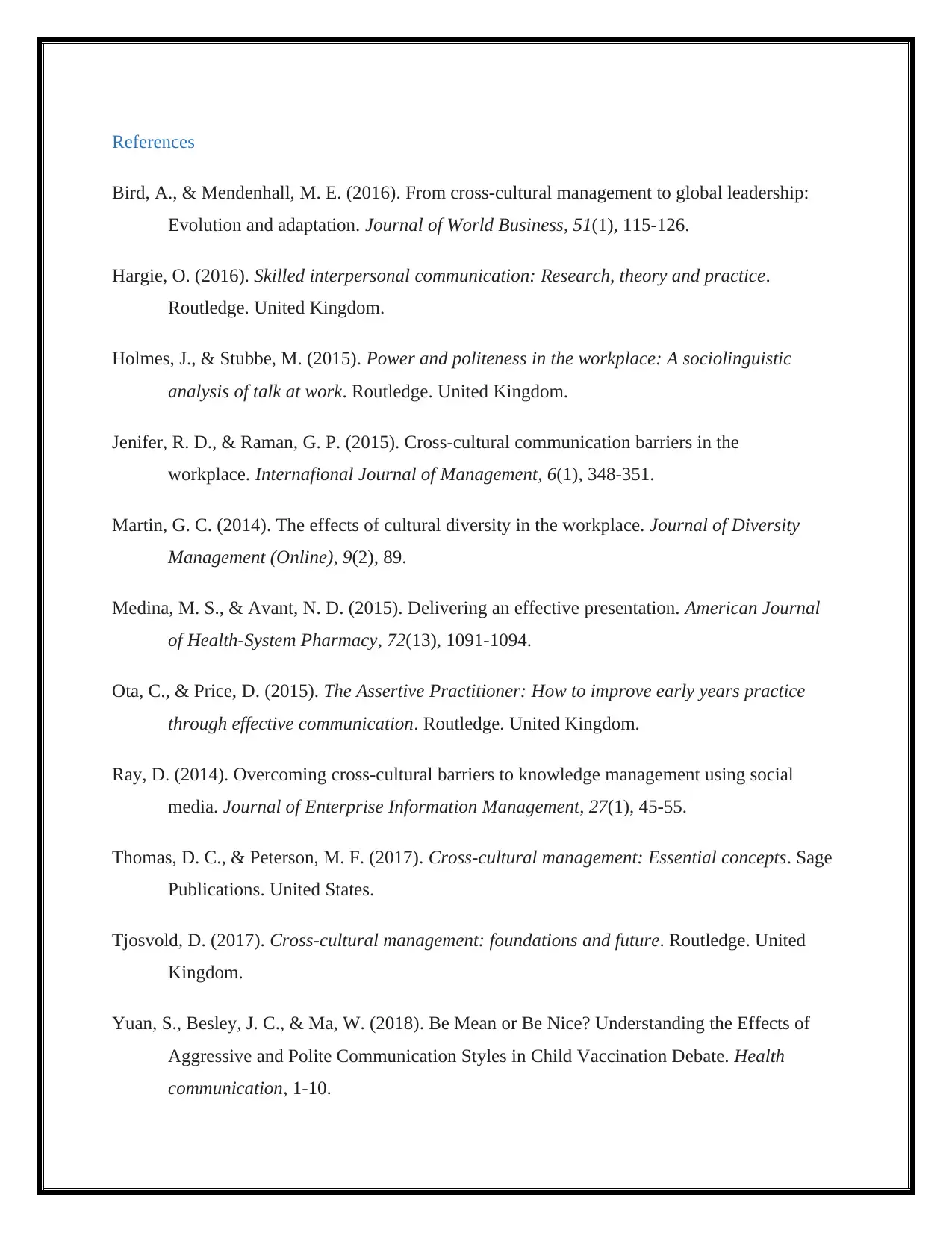
References
Bird, A., & Mendenhall, M. E. (2016). From cross-cultural management to global leadership:
Evolution and adaptation. Journal of World Business, 51(1), 115-126.
Hargie, O. (2016). Skilled interpersonal communication: Research, theory and practice.
Routledge. United Kingdom.
Holmes, J., & Stubbe, M. (2015). Power and politeness in the workplace: A sociolinguistic
analysis of talk at work. Routledge. United Kingdom.
Jenifer, R. D., & Raman, G. P. (2015). Cross-cultural communication barriers in the
workplace. Internafional Journal of Management, 6(1), 348-351.
Martin, G. C. (2014). The effects of cultural diversity in the workplace. Journal of Diversity
Management (Online), 9(2), 89.
Medina, M. S., & Avant, N. D. (2015). Delivering an effective presentation. American Journal
of Health-System Pharmacy, 72(13), 1091-1094.
Ota, C., & Price, D. (2015). The Assertive Practitioner: How to improve early years practice
through effective communication. Routledge. United Kingdom.
Ray, D. (2014). Overcoming cross-cultural barriers to knowledge management using social
media. Journal of Enterprise Information Management, 27(1), 45-55.
Thomas, D. C., & Peterson, M. F. (2017). Cross-cultural management: Essential concepts. Sage
Publications. United States.
Tjosvold, D. (2017). Cross-cultural management: foundations and future. Routledge. United
Kingdom.
Yuan, S., Besley, J. C., & Ma, W. (2018). Be Mean or Be Nice? Understanding the Effects of
Aggressive and Polite Communication Styles in Child Vaccination Debate. Health
communication, 1-10.
Bird, A., & Mendenhall, M. E. (2016). From cross-cultural management to global leadership:
Evolution and adaptation. Journal of World Business, 51(1), 115-126.
Hargie, O. (2016). Skilled interpersonal communication: Research, theory and practice.
Routledge. United Kingdom.
Holmes, J., & Stubbe, M. (2015). Power and politeness in the workplace: A sociolinguistic
analysis of talk at work. Routledge. United Kingdom.
Jenifer, R. D., & Raman, G. P. (2015). Cross-cultural communication barriers in the
workplace. Internafional Journal of Management, 6(1), 348-351.
Martin, G. C. (2014). The effects of cultural diversity in the workplace. Journal of Diversity
Management (Online), 9(2), 89.
Medina, M. S., & Avant, N. D. (2015). Delivering an effective presentation. American Journal
of Health-System Pharmacy, 72(13), 1091-1094.
Ota, C., & Price, D. (2015). The Assertive Practitioner: How to improve early years practice
through effective communication. Routledge. United Kingdom.
Ray, D. (2014). Overcoming cross-cultural barriers to knowledge management using social
media. Journal of Enterprise Information Management, 27(1), 45-55.
Thomas, D. C., & Peterson, M. F. (2017). Cross-cultural management: Essential concepts. Sage
Publications. United States.
Tjosvold, D. (2017). Cross-cultural management: foundations and future. Routledge. United
Kingdom.
Yuan, S., Besley, J. C., & Ma, W. (2018). Be Mean or Be Nice? Understanding the Effects of
Aggressive and Polite Communication Styles in Child Vaccination Debate. Health
communication, 1-10.
⊘ This is a preview!⊘
Do you want full access?
Subscribe today to unlock all pages.

Trusted by 1+ million students worldwide

1 out of 10
Related Documents
Your All-in-One AI-Powered Toolkit for Academic Success.
+13062052269
info@desklib.com
Available 24*7 on WhatsApp / Email
![[object Object]](/_next/static/media/star-bottom.7253800d.svg)
Unlock your academic potential
Copyright © 2020–2025 A2Z Services. All Rights Reserved. Developed and managed by ZUCOL.




